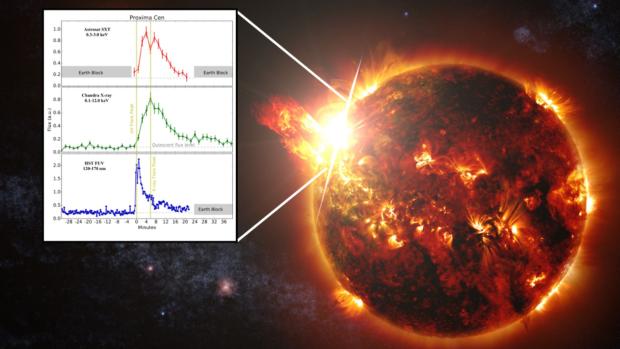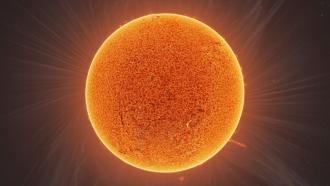
An artist impression of the flare observed on our nearest exoplanet hosting neighbor-Proxima Centauri (Image Credit: NASA Goddard space flight center). Zoom in shows the light curves of the flare observed by our team on Proxima Centauri with the Astrosat SXT in 0.3-3.0 keV (top panel), Chandra LETG zeroth order in 0.1-12.0 keV (middle panel) and HST FUV in 120-170nm (bottom panel) on 31 May 2017. Courtesy: Indian Institute of Astrophysics.
Aliens and extra-terrestrial life (life forms outside our Earth), is a continuous quest for humankind and numerous space missions have been launched to look for life. We have probes scouting for life in the nearest asteroid up until the farthest planet in our Solar System and beyond, and now scientists say ‘cool dwarfs’ stars are our best bet in finding clues about that elusive life.
A ‘cool dwarf’ is a stellar object with a temperature of about 3000 °C or less (the temperature of our Sun, for comparison, is about 5505°C). Due to their slow rate of hydrogen fusion, they live on for many hundreds of billions of years with the smallest living for trillions of years! As the age of the universe is only 13.8 billion years, all cool dwarf stars are relatively young.
The good news is that our galaxy, the Milky Way, is made up of nearly 75% such cool dwarfs. One of our neighbours, Proxima Centauri, is one such star with an Earth-like planet, Proxima Centauri b, and many scientists believe that this planet may be habitable. But how do we know? For life to be sustainable on any planet, high-energy radiation resulting from the chromospheric and coronal activity of the host star plays a crucial role, say scientists.
“The high-energy photons like the UV and X-ray photons are absorbed by the planetary atmosphere heating it to 10s of 1000s of Kelvin, affecting the capability of the planet to sustain its atmosphere and in particular to sustain water in liquid form”, says Dr. Lalitha Sairam from the Indian Institute of Astrophysics, Bengaluru.
To learn more about the possibility of life on Proxima Centuari b, a team of scientists from Germany, India, US, Chile and France came together to observe the Proxima Centauri system using both space-based and ground-based telescopes. The collaborative project consisted of researchers from the Indian Institute of Astrophysics, Bengaluru, Tata Institute of Fundamental Research, Mumbai, Universität Hamburg, Germany, Max Planck Institute for Extra-terrestrial Physics, Germany, University of Colorado, US, Universität Berlin, Germany, Astronomisches Rechen-Institut, Germany, University of London and Laboratoire d'Astrophysique, France.
On 31 May 2017, three space-based observatories – India’s Astrosat, NASA’s Chandra and NASA’s and ESA’s Hubble Space Telescope, along with a ground-based observatory High Accuracy Radial velocity Planet Searcher (HARPS), participated in this exciting exercise and have detected a coronal explosion -- an unusually large release of plasma and magnetic field from a star – in Proxima Centauri.
“The analysis of the observed flare data suggests that the flux increases to several orders of magnitude in both X-rays and UV wavelengths and lasting about 1800 seconds. The energy released during this flare is of the order of ~1030 erg”, remarks Dr. Lalitha Sairam who was also involved in this study.
“The typical energy released during a solar flare is of the order of 1026-28 erg. If a flare like the one observed on Proxima Centauri occurs on our Sun, it might have a devastating effect on our power-grids, cause interruption of broadcast and electricity, affect the electronic instruments as well as astronauts in space”, says Prof. K.P. Singh from Tata Institute of Fundamental Research (TIFR), Mumbai.
The team is now trying to understand what effects such high coronal explosions would have on the planet. “Such powerful and frequent flaring events may produce large radiations and particles which may significantly influence the atmosphere of the Proxima Centauri b and affect its habitability”, says Prof. Jürgen Schmitt from University of Hamburg, Germany, and was part of this team.
This discovery is a proud moment for Indian astronomy because of Astrosat’s contribution in this effort. “For first time Astrosat is part of such a large observing campaign with other space-based observatories like Chandra and Hubble“ says Prof. Singh who also developed the Soft X-ray Telescope aboard Astrosat, India's first dedicated multi-wavelength space observatory launched in September 2015.
Update: This is not vetted by IIA Media Committee but based on a release from IIA and TIFR.






